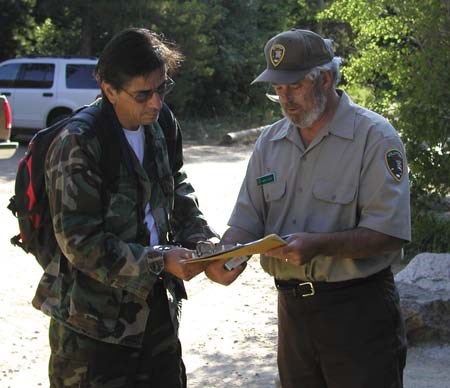Last updated: February 13, 2023
Article
Factors Affecting the Wilderness Experience

The Question: What sights and sounds influence a wilderness experience for backcountry visitors in Rocky Mountain National Park?
Ninety-five percent of Rocky Mountain National Park is backcountry, 3,000 acres of which are designated as wilderness. Two-hundred fifty thousand more acres in the park are managed as de facto wildernss pending a final legislative decision. With more and more people using these areas every year, park managers are concerned with making decisions that maximize the wilderness experience for everyone. Managers need to know what people are seeking in a wilderness experience when they come to the park.
The Project: Survey, use visitor-employed photography, and gather information from visitors in 2002.
During the summer of 2002 members of the Political Analysis and Science Assistance
Program, the Fort Collins Science Center, the U.S. Geological Survey, park personnel,
park volunteers, and the Natural Resource Recreation and Tourism program at Colorado State University undertook this study to investigate numbers of backcountry users, what affected their wilderness experiences, and what they prefer to experience in the wilderness. They distributed 293 single-use cameras to account users at trailheads throughout the park. They asked each visitor to record details about each picture they took including what sounds they heard at the time. After the pictures were developed, the researchers returned a copy to the visitors with another survey. The team analyzed all the information from the surveys and the photographs.
The Results: Sights and sounds enhance the wilderness experience if they reflect wilderness or efforts to preserve it. They detract from the wilderness experience if they reflect everyday life or the destruction of wilderness.
Natural features appeared in 80 percent of the 2,930 photos taken. The most popular subjects were running water, trees, mountains, glaciers, and scenic vistas. Ninety-three percent of the natural subjects had a positive effect on the wilderness experience. Nonnatural subjects were considered desirable if they facilitated the wilderness experience or provided access to the wilderness. Nonnatural subjects were considered undesirable if they suggested degradation of the wilderness or interference with the wilderness experience.
Seventy-seven percent of the sounds reported were natural in origin. The most desirable sounds were birds and water. The most unpleasant sounds reported were cellular phones and airplanes. Human voices were acceptable if they did not suggest overcrowding of an area. Mechanized sounds in general were felt to be out of place and undesirable.
The most common desirable characteristics of wilderness were aesthetics, physical escape, and solitude.
This summary is based on published, peer-reviewed and/or unpublished reports available at the time of writing. It is not intended as a statement of park policy or as a definitive account of research results.
For more information on the park’s research program, see www.nps.gov/romo
Updated: January 2008 Photo credit: NPS-RMNP
